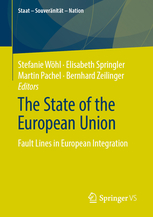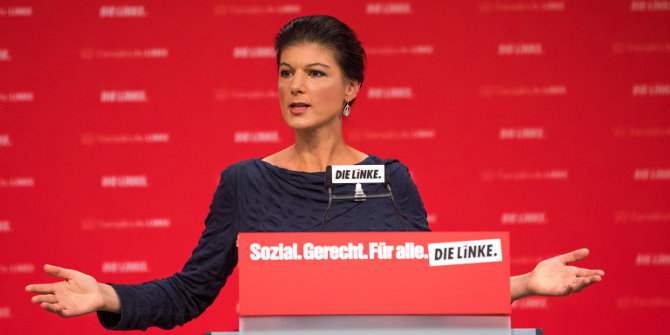In The State of the European Union: Fault Lines in European Integration, Stefanie Wöhl, Elisabeth Springler, Martin Pachel and Bernhard Zeilinger offer a new collection analysing European integration after the 2008 financial crisis, providing a critique of European economic reforms and insight for progressive European policies. The volume adds new voices and viewpoints to European Studies, enriching and pluralising the debate, writes Vanessa Bilancetti.
The State of the European Union: Fault Lines in European Integration.Stefanie Wöhl, Elisabeth Springler, Martin Pachel and Bernhard Zeilinger (eds.). Springer VS. 2020.
 The State of the European Union is an edited collection analysing European integration after the economic breakdown of 2008 from a critical point of view. With similar aims to Johannes Jäger and Elisabeth Springler’s 2015 collection Asymmetric Crisis in Europe and Possible Futures, this is a valuable book that brings together ‘heterodox economic and political science approaches focusing on the analysis of neo-Gramscian and post-Keynesian scholars’ (9), providing a critique of the European economic reforms and insight for progressive European policies.
The State of the European Union is an edited collection analysing European integration after the economic breakdown of 2008 from a critical point of view. With similar aims to Johannes Jäger and Elisabeth Springler’s 2015 collection Asymmetric Crisis in Europe and Possible Futures, this is a valuable book that brings together ‘heterodox economic and political science approaches focusing on the analysis of neo-Gramscian and post-Keynesian scholars’ (9), providing a critique of the European economic reforms and insight for progressive European policies.
Since the entering into force of the Lisbon Treaty in 2009, the President of the European Commission’s annual September speech in front of the plenary session of the European Parliament has been titled ‘The State of the European Union’. This speech resumes the challenges and risks of the political year to come, and since the first speech in 2010, given by then President José Manuel Durão Barroso, it has become a moment to reflect upon European integration. Following the Lisbon Treaty rationale, this speech was supposed to represent a stronger institutional connection between the European Commission and the European Parliament, embodying a more accountable and democratic EU. Yet, in the years since, this speech has become the expression of the emerging divisions between European institutions and EU member states. Indeed, many speeches have been centred on proposed reforms – such as the Eurobond or refugee quotas – that have never been realised.
Hence, this book reasons around the ‘state of the European Union’, but by following its Fault Lines, as we read in its subtitle. In geological terms, a fault line is the place where fractures in the rocks of the Earth can be traced and mapped. Movements originated by tensional forces occurring along these faults are the first cause of earthquakes. This is a common metaphor in political language, and in this case could also be seen as a methodological metaphor: these scholars are mapping fractures in European integration to analyse the different crises experienced by the EU. Following the fault lines of European integration can give us a lens through which to read the management of the financial crises, and the correlated migration and democratic crises which have unfolding in the last ten years. For the same reason, this book could be interesting reading as a new health emergency is unravelling, also triggering new economic, political, institutional and democratic crises.
In the immediate aftermath of the financial crisis, a debate about heterodox economics ‘attempted to reclaim momentum in economic educational institutions and the economic political agenda’ (5). But this window of opportunity closed up quickly when the crisis arrived in Europe. Here, the narration on the financial crisis changed from it being viewed as a crisis caused by the irresponsible use of derivatives by the private financial sector to a public debt crisis caused by some irresponsible governments that had falsified their budgets. This has turned the public debate towards the necessity of cutting public debt and disciplining irresponsible governments. In European Studies, this has meant the marginalisation of critical voices, returning to the traditional division between political science and economics on which European integration theories have been founded. Hence, dissenting voices in European Studies are scarce, underfunded and tend to remain in their national space, being rarely translated into other languages. This is another reason why this collection is valuable reading, because it translates a German-speaking debate that rarely reaches English-speaking academia.
In the first part of the collection, which concerns economic and democratic governance, Lukas Oberndorfer’s chapter introduces the category, inspired by Nicos Poulantzas, of ‘authoritarian competitive statism’. This idea can help us to deconstruct the binary division between supranationalism and nationalism on which the mainstream debate is based. For Oberndorfer, the EU can be read as an ensemble of state apparatuses in constant competition between themselves, where governments are part of the European game and not opposed to it. Under pressure, this ensemble is reconfiguring its rules towards a more authoritarian mode of governance. This means: a constant devaluation of representative democracy on any level of government; massive empowerment of the European executive; the flexibilisation of the relations between different scales of government, legitimising the empowerment of the apparatuses of the dominant state; and the erosion of the rule of law. Therefore, the fault line here is not between European and national governments, but between the ‘European ensemble of state apparatuses vs (representative) democracy’ (36).
This shift of power towards European and national executives is highly gendered, as is well explained by Elizabeth Klatzer and Christa Schalager, because the new economic governance and austerity measures ‘privilege masculinized economic knowledge with its norm of competitiveness for growth […] The point is not solely that most decision makers in these institutions are male, but that these actors, structures, and proceedings share a conservative image of masculinity and values’ (52-53).
Each part of this collection is able to shed a new light on the public debate about the EU. In the second part of the book on ‘Right-Wing Populism and the Extreme Right’, Samuel Salzborn is able to uncover how right-wing populist parties in Europe share the same historical political background as extreme-right parties, even though they are ‘pursuing different strategic options to reach their goals’ (125). These different strategic options are sometimes classified as ‘populist’, drawing a distinction in the extreme-right party family, but the populist option is ‘extremely dependent on the political structure in place’ (124). On the contrary, the differences between right-wing parties lie in their position towards the EU and their historical references to Nazism and fascism. Based on these two issues, Salzborn classifies sixteen right-wing parties of twelve European countries to come to the conclusion that there is an ‘heteregenous but nevertheless integrated family of right-wing extreme parties’ (124).
In the third part on ‘Financialization and Militarization’, Hans-Jürgen Bieler deconstructs any idea of the supposed ‘re-regulation’ of the financial market, explaining how some European regulations are actually re-opening the space for a new financialisation of the economy. In fact, all the measures promulgated in the first phase of the crisis, such as the European Stability Mechanism (ESM) or the European Banking Union (EBU), were not transforming economic or financial regulation, but rather had the aim to stabilise the system. The resulting austerity measures had ambiguous effects: on the one hand, they depressed the cycle; on the other hand, the reduction of public spending has fostered privatisation, accelerating financialisation. In any case, after the crisis and the related political and social unrest, most political parties are more hesitant about fostering the deregulation of infrastructure and social security, therefore financialisation is becoming increasingly related to the housing market and privatisation outside the EU, enhancing the ‘crisis vulnerability of European financial market capitalism’ (149).
Finally, the fourth section of the book on ‘Social Exclusion, Welfare and Migration Policies’ dismantles the idea of the EU as a human rights defender inside and outside its borders. In their chapter, Zeilinger and Christian Reiner try to answer the question of why and how governments pursue controversial welfare reforms in the face of institutional and social resistance. They answer this question through an in-depth econometric analysis, discovering that ‘political orientations variables are almost irrelevant’ (249) in explaining cuts to social expenditure. Hence, for the two authors, it seems that ‘the austerity policy is more or less independent of political ideology’ (249): a result and a cause of its persistent dominance.
Unfortunately, the collection misses a conclusion, where it would have been possible to draw some new research lines for critical European Studies. In summary, this is a collection that adds new voices and viewpoints to European Studies, enriching and pluralising the debate, and would be recommended for postgraduate syllabuses on European integration and International Relations.
Please read our comments policy before commenting.
Note: This article is provided by our sister site, LSE Review of Books. It gives the views of the author, not the position of EUROPP – European Politics and Policy or the London School of Economics. Featured image: Christian Lue on Unsplash
_________________________________
Vanessa Bilancetti – Uninettuno
Vanessa Bilancetti received her PhD in Politics from the University of Rome La Sapienza. She was a Visiting Fellow at the University of Sheffield, and is now a Lecturer in Political Sociology at the online University Uninettuno. Her research interests include the European Union, financialisation, feminist political economy and critical European studies. She is now developing research on the commodification process of welfare regime in the European Union.




